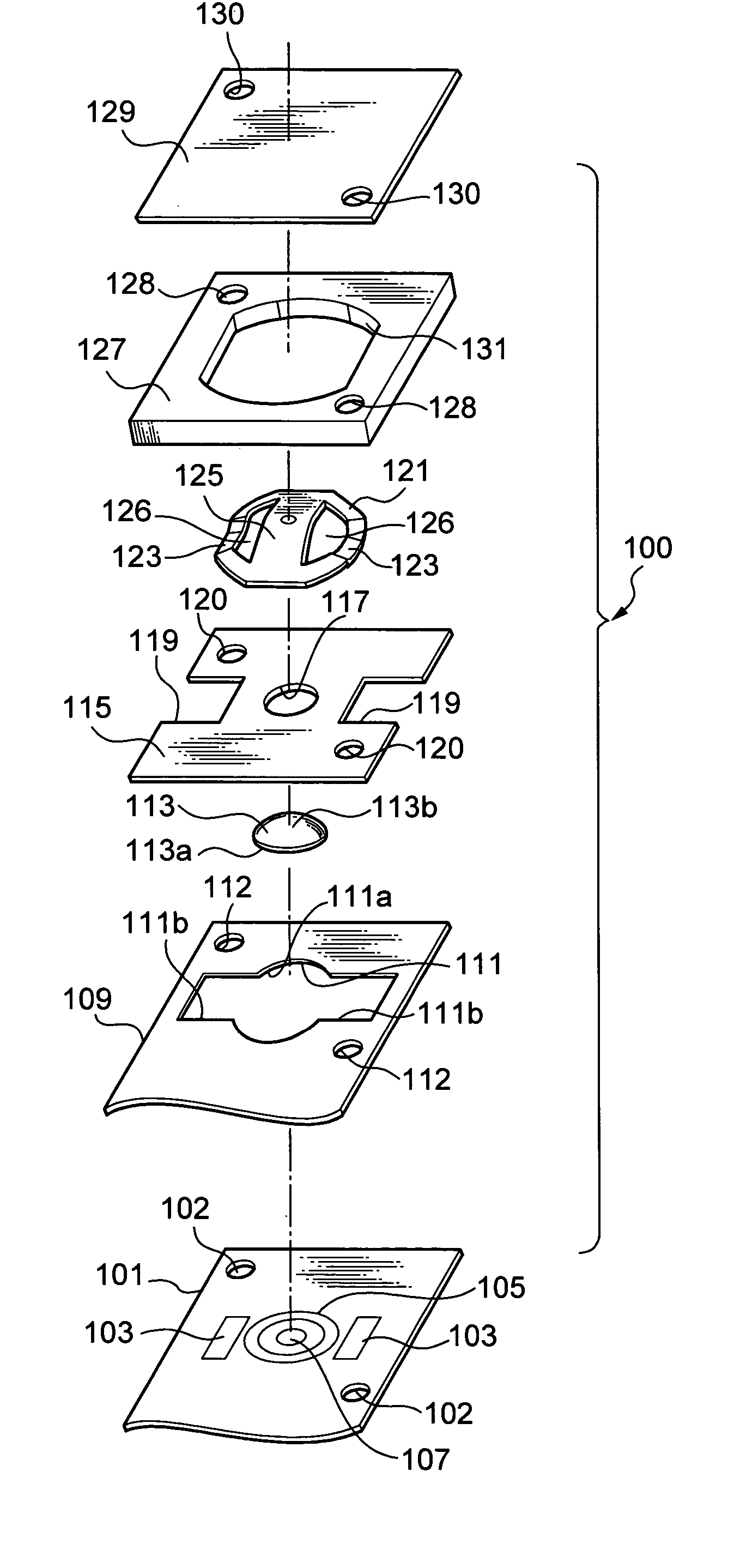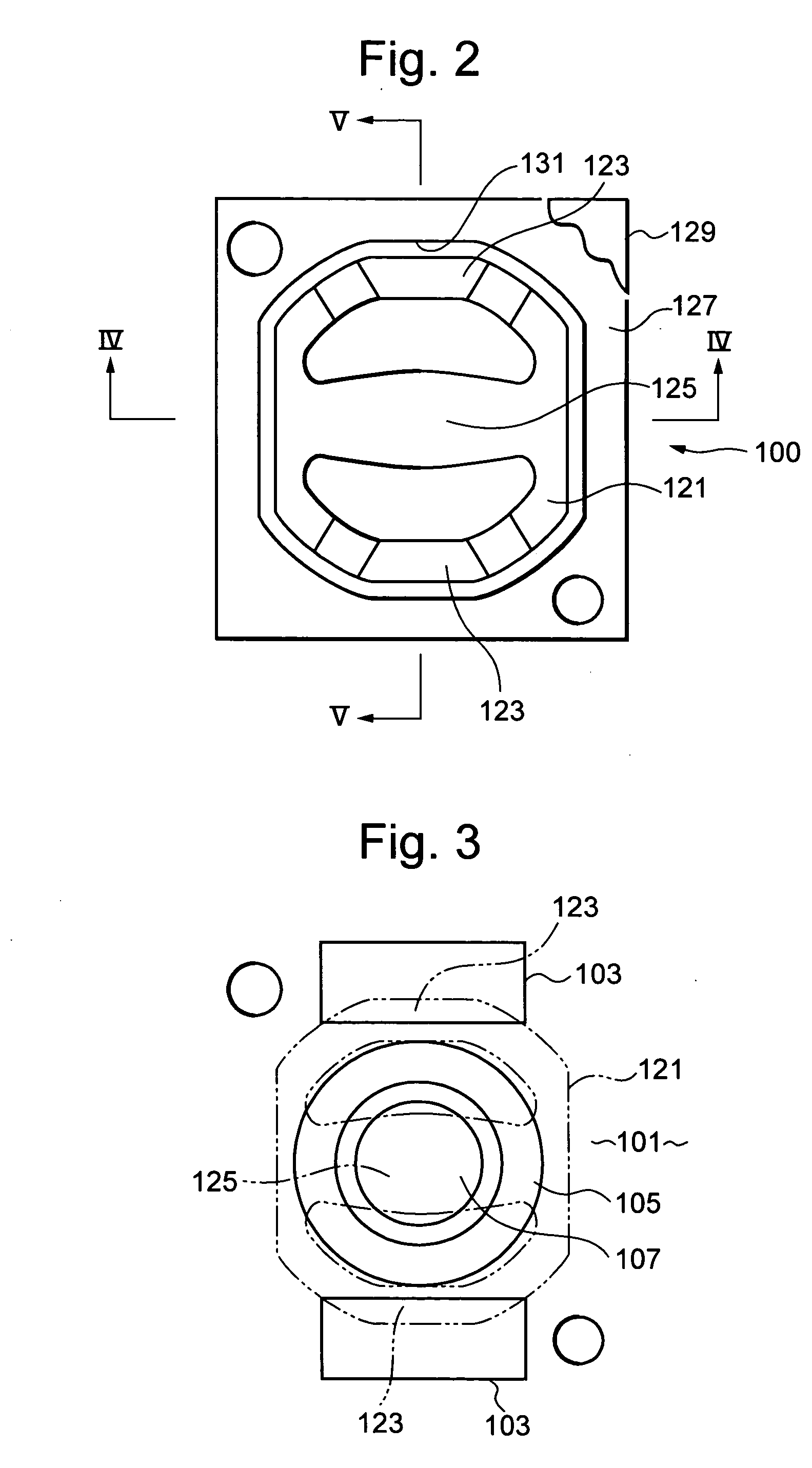Two-step switch
a two-step switch and switch body technology, applied in the direction of switch side location, contact surface shape/structure, movable contacts, etc., can solve the problems of difficult to provide such different levels on the printed circuit board, the size of the switch would become larger, and the inability to provide a small-size two-step switch
- Summary
- Abstract
- Description
- Claims
- Application Information
AI Technical Summary
Benefits of technology
Problems solved by technology
Method used
Image
Examples
first embodiment
[0053] A first embodiment of the present invention will now be described with reference to FIGS. 1 through 9. FIG. 1 is an exploded perspective view of a two-step switch 100 according to the first embodiment, FIG. 2 is a plan view of the two-step switch 100, FIG. 3 is a plan view of a printed circuit board, FIG. 4 is a sectional view as seen by the line IV-IV of FIG. 2, and FIG. 5 is a sectional view as seen by the line V-V of FIG. 2.
[0054] As illustrated in FIGS. 1 and 3, there is a printed circuit board 101, on which, first fixed contacts 103, a second fixed contact 105, and a third fixed contact 107, are provided. The printed circuit board 101 has penetrating holes 102, 102, at positions diametrically opposite to each other, into which fixing screws (not shown) are inserted respectively.
[0055] Further, as illustrated in FIGS. 1, 4 and 5, there is an adhesive sheet 109, serving as a second insulation sheet, positioned above the printed circuit board 101. The adhesive sheet 109 h...
second embodiment
[0072] A second embodiment of the present invention will now be described with reference to FIG. 10. According to the second embodiment, the both ends of the first contact spring 121 according to the first embodiment are formed in bowing shapes toward the lower side, at which projecting chips are provided, respectively serving as the outer peripheral contacts 123, 123. As illustrated in FIG. 10, the outer peripheral contacts 123, 123 project, not only in radial direction, but also toward the opposite side of the protruding part. Thus, it is further possible to secure the height, in particular the stroke.
[0073] The other structure is substantially the same as that of the first embodiment, so the identical reference numerals are given to the identical parts, and the detailed explanation will not be done here.
third embodiment
[0074] A third embodiment of the present invention will now be described with reference to FIGS. 11 and 12. According to the first and second embodiments, as an example, the two-step switch is positioned on the side surface of the portable telephone. However, the present invention is not limited to that example.
[0075] According to the third embodiment, the two-step switch is positioned at the upper part of the front surface of a portable telephone. According to the third embodiment, it is also possible to obtain substantially the same effect as those of the first and second embodiments.
[0076] The other structure is substantially the same as that of the first and second embodiments, so the identical reference numerals are given to the identical parts, and the detailed explanation will not be done here.
PUM
 Login to View More
Login to View More Abstract
Description
Claims
Application Information
 Login to View More
Login to View More - R&D
- Intellectual Property
- Life Sciences
- Materials
- Tech Scout
- Unparalleled Data Quality
- Higher Quality Content
- 60% Fewer Hallucinations
Browse by: Latest US Patents, China's latest patents, Technical Efficacy Thesaurus, Application Domain, Technology Topic, Popular Technical Reports.
© 2025 PatSnap. All rights reserved.Legal|Privacy policy|Modern Slavery Act Transparency Statement|Sitemap|About US| Contact US: help@patsnap.com



